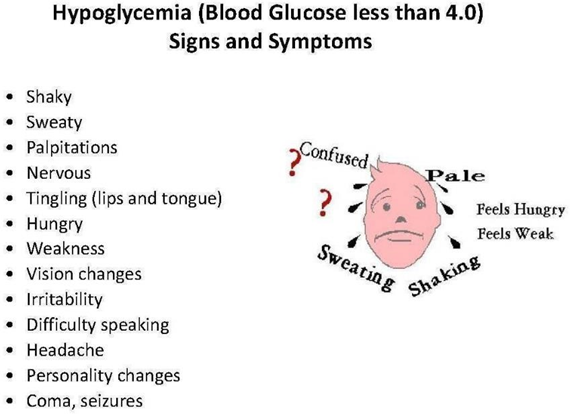A nurse is providing teaching to a client who has a new diagnosis of type 2 diabetes mellitus. The nurse should recognize that the client understands the teaching when he identifies which of the following as manifestations of hypoglycemia? (Select all that apply.)
Tachycardia
Polydipsia
Polyuria
Blurred vision
Moist, clammy
Correct Answer : A,D,E
A. Tachycardia, or increased heart rate, can occur during hypoglycemia as a result of the body's response to low blood sugar levels. The sympathetic nervous system is activated, leading to increased adrenaline (epinephrine) release, which can cause palpitations and tachycardia.

B. Polydipsia refers to excessive thirst. It is typically a symptom of hyperglycemia (high blood sugar levels) rather than hypoglycemia. During hypoglycemia, thirst is not a common symptom.
C. Polyuria refers to excessive urination. Similar to polydipsia, it is more commonly associated with hyperglycemia (high blood sugar levels) rather than hypoglycemia. Hypoglycemia typically does not cause polyuria.
D. Blurred vision can occur during hypoglycemia due to changes in the shape of the lens in the eye caused by altered fluid balance due to low blood sugar levels.
E. Moist, clammy skin is a common manifestation of hypoglycemia. When blood sugar levels drop, the body's autonomic nervous system responds by releasing adrenaline, which can cause sweating and clamminess.
Nursing Test Bank
Naxlex Comprehensive Predictor Exams
Related Questions
Correct Answer is D
Explanation
A. Catheter irrigation involves flushing the catheter with a sterile solution to clear any obstruction within the tubing or catheter itself. It can help in cases where there might be clots obstructing urine flow. However, irrigating the catheter is an intervention that requires proper assessment and order from the healthcare provider.
B. This option suggests adjusting the rate of the bladder irrigant, which typically refers to the irrigation solution used during the TURP procedure to maintain catheter patency and prevent clot formation. However, this action requires assessment of the situation and potential orders from the provider.
C. Notifying the provider is often the first action the nurse should take when encountering a significant change in the client's condition or a potential complication, such as a blocked catheter. The provider needs to be informed so they can assess the situation, provide further orders, and decide on the appropriate course of action to manage the urinary retention effectively.
D. Checking the tubing for kinks or other external obstructions is a prudent initial action. Kinks or twists in the catheter tubing can prevent urine from draining properly. If a kink is identified, it can be corrected immediately, allowing urine to flow freely again.
Correct Answer is A
Explanation
A. Proper oral hygiene is crucial for preventing ventilator-associated pneumonia (VAP), which is a common complication in ventilated patients. The bundle often includes instructions on how to perform mouth care to reduce the risk of bacterial colonization in the oral cavity and subsequent aspiration into the lungs.
B. Tracheostomy care, including suctioning as needed, is important to maintain airway patency and prevent complications like mucus plugging. However, specific instructions for suctioning frequency (e.g., every 2 hours) may vary based on the patient's clinical condition and the presence of secretions. It is not universally part of the ventilator care bundle but is an essential component of managing patients with tracheostomies.
C. Correct ventilator settings are critical to support adequate oxygenation and ventilation while minimizing lung injury. Nurses should be knowledgeable about how to monitor and adjust ventilator settings based on the patient's respiratory status. Education on ventilator settings may be included in
training related to mechanical ventilation management, but it is not typically part of a standardized ventilator care bundle.
D. The position of the patient can affect ventilation and respiratory mechanics. In the context of ventilator care, positioning recommendations may include elevating the head of the bed (semi-Fowler's position) to reduce the risk of aspiration and improve lung expansion. Placing the client in a supine position alone is not specific to the ventilator care bundle but may be considered based on the patient's clinical condition.
Whether you are a student looking to ace your exams or a practicing nurse seeking to enhance your expertise , our nursing education contents will empower you with the confidence and competence to make a difference in the lives of patients and become a respected leader in the healthcare field.
Visit Naxlex, invest in your future and unlock endless possibilities with our unparalleled nursing education contents today
Report Wrong Answer on the Current Question
Do you disagree with the answer? If yes, what is your expected answer? Explain.
Kindly be descriptive with the issue you are facing.
